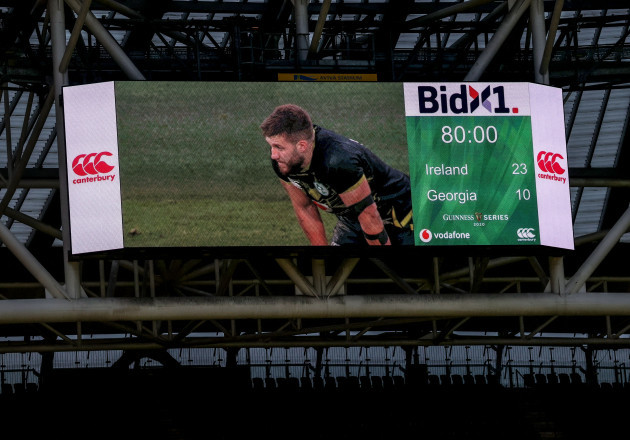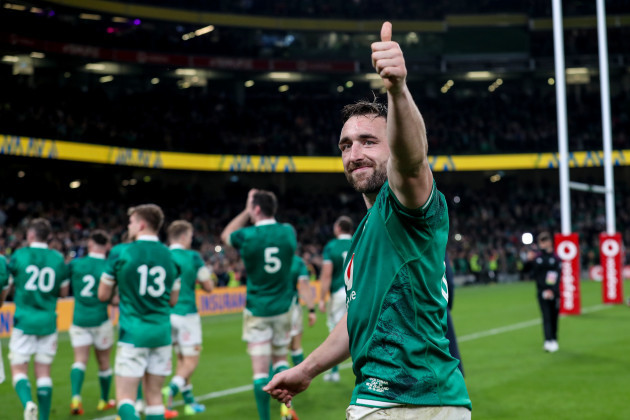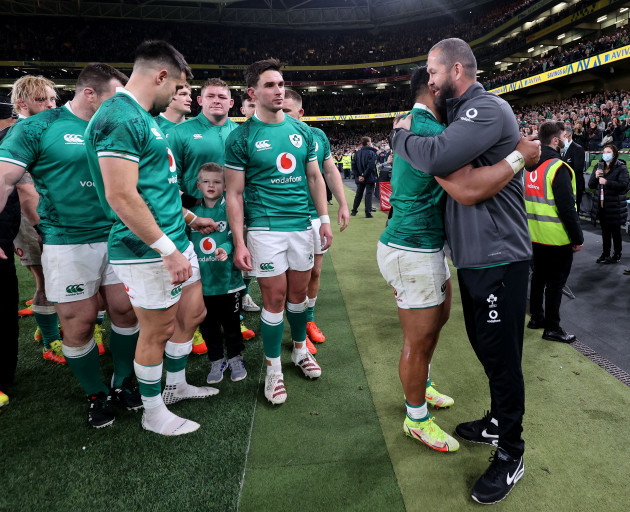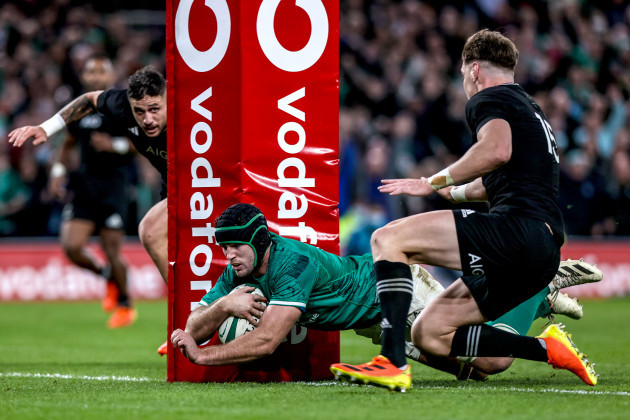ONE YEAR. THAT is the length of time that has elapsed since Georgia came to Dublin and frightened the life out of Andy Farrell.
They left with respect but not the result. Ireland prevailed, 23-10, but sometimes the scoreline does lie. It was a hell of a lot closer, a hell of a lot scarier.
Looking back at that Ireland team now, you’d wonder where the turnaround has come from. They didn’t then look like a side who would put a seven-game winning streak together in 2021, a run that would see them dismantle England, hammer Japan, then defeat the All Blacks.
After Saturday, Johnny Sexton made a point about how he knew Ireland had that kind of performance in them. Well, they did a good job of keeping the secret to themselves because when the year turned, and 2020 was left behind, no one was predicting a third victory in five over New Zealand.
So what explains the transformation? How do you go from being so poor to so good in just under a year?
Like most answers, there was no easy solution.
TEAM SELECTION
He’s managed to turn it around, Farrell, and you only have to look at his selection policy for a reason why. Pick your best 15 and you stand a chance. It’s that simple.
A year ago he couldn’t. Caelan Doris, Jack Conan and Tadhg Furlong were injured; Johnny Sexton was also showing signs of wear and tear; Joey Carbery was another who’d yet to emerge from the medical room. But other factors were within Farrell’s control. He could have selected Hugo Keenan at full-back rather than wing. He could have ignored Billy Burns for Jack Carty or Harry Byrne.
In any case, as spring gave way to summer and then autumn, the Ireland coach increasingly became bolder and more self-assured in his selections. It was his call to ask Andrew Porter to permanently switch from tighthead to loosehead; his call to promote the precocious Ronan Kelleher ahead of lineout expert, Rob Herring; his call to select Caelan Doris over Peter O’Mahony.
And then there were the unexpected cases he championed. There were no outside campaigns whatsoever for Jamison Gibson-Park, James Lowe or Andrew Conway to start the Japan game, never mind the New Zealand one. Prior to then he placed his faith in Conan against England, the No8 ending up a Test starter for the Lions during the summer.
The upshot was last Saturday. If his predecessor, Joe Schmidt, was guilty of being too loyal to old soldiers who’d previously served him well, Farrell has become increasingly unafraid to make what looks like risky decisions. On the flip side, he’d got it wrong frequently enough beforehand. Too much faith was placed in Burns; too much time given to the Stockdale experiment at full-back.
But look at last Saturday’s team. Kelleher, Doris, Gibson-Park, Lowe and Keenan have made their debuts on his watch; Conan, Conway and Porter have been upgraded from the bench at the 2019 World Cup to the starting XV. He has selected 59 different players, handing out 23 new caps, in his two years in charge and yet is consistently tagged with the conservative label.
What he has now is a group of skilful, physically athletic, hungry players. When your pack contains a front row like Porter, Kelleher and Furlong, you readily get across the gainline; when the second battalion contains Doris, Ryan and Henderson, you are making yards rather than feet. To play with ambition, to implement the ‘heads up rugby’ philosophy he has so often talked about, it helps to have a pack as mobile and as technically proficient as Ireland’s. Or to put it another way, Porter, Kelleher and Doris are a better version of Healy, Herring and Stander. They proved that point on Saturday.
HAPPY CAMP
When he was 17, Andy Farrell was told to move his gear bag from the wooden hut at Wigan’s training ground and knock on the door with FIRST TEAM printed in big, bold letters.
It seems such a small thing now, especially as Farrell had already made his debut for the side two months earlier. But for a teenage boy, surrounded by pals his own age, he was happier to stay where he was rather than to sit alongside the hard-nosed warriors who were in the middle of a record-breaking streak of eight successive Challenge Cup wins.
The point is that dressing rooms, its stink of mud, deep-heat, sweat and aftershave is the office he has known since he was a teenager – a place he’s completely comfortable with.
“He pushes the right buttons when teams need him to do so,” Warren Gatland said of the Ireland coach. “Andy is one of the most exceptional people I have ever seen in sport who can understand an environment, the mood of camps.
“That is not a skill you learn. It’s something innate. And it comes from his life experiences, being captain of a group of men for club and country at 21, playing at an elite level all his adult life. This Ireland job has come at the right time for him.”
It came at the right time for Ireland’s players, too. It’s easy to oversee a happy camp when the team is on a roll; much more difficult to do so when they are losing and when they are stuck in a hotel bubble due to covid restrictions.
Yet this is where Ireland found themselves earlier this year, going zero from two in their opening games of the Six Nations. Come the final day of the campaign, they had turned it around, outplaying England, an England side whose players had openly complained about how ‘challenging’ they were finding their bubble environment. In contrast to Eddie Jones, Farrell had created the right mood. The win over England was evidence of that.
MIND GAMES
Getting Gary Keegan in as a performance guru was a smart move. Waiting a year before he did so was not.
Nonetheless, while it should have happened sooner – if not Keegan then someone of his ilk – the evidence of Ireland’s improved mental strength was visible to everyone’s eyes last weekend.
At half-time they trailed 10-5 when really they had enough possession and territory to be leading by 15 points. Seeing Codie Taylor nail a score out of nothing just seconds after Furlong’s try had been wiped out was an invitation for players to indulge in self-pity. Instead they produced a superb opening to the second half and then held their nerve to seal the deal late on.
Best of all, though, was their resistance to giddiness afterwards.
“There is definitely room for improvement individually,” said Sexton afterwards. “We need to keep our feet on the ground and keep improving.”
Mentally they certainly appear strong, at the very least calm. It has taken them a while to reach this point.
TACTICAL MARRIAGE
Under Joe Schmidt, Ireland relied on a gameplan based on ball retention, winning collisions, making low-risk kicks, spiced up by some trademark moves off the set-piece that often made fools of the opposition (think Stockdale’s try against New Zealand in 2018). It got results, until the very end that is, when everyone had figured out a way to counteract it.
Come 2020, there was a new coach and a new philosophy. “Heads up rugby,” Farrell called it. The truth is it sounded like a marketing slogan rather than a deeply thought-out plan yet it isn’t what a coach says in a press conference that counts, more what his team does on the pitch.
So we made up our minds based on what we saw rather than what we heard. Still, the early conclusions weren’t terribly complimentary. Ireland still boxkicked a lot but not as much as before; they tried some complicated passing moves that rarely came off; worryingly their set-piece was not as good as it once was under Schmidt.
By spring 2021, something had changed. Paul O’Connell was now on the coaching ticket. Those who have worked with O’Connell in the past have spoken at length about his obsessive attention to detail, how he’d go frame by frame through lineout footage and come up with a plan on the back of that.
Here, with Ireland, his knowledge was being passed on to the next generation. Throughout the Six Nations, Ireland kept getting top marks in this department, their breakdown work also improving, again on the back of O’Connell’s input.
Problems remained elsewhere, namely in attack and defence resulting in Farrell, Mike Catt and Simon Easterby getting a fair degree of flak in the early part of this year.
All three have credit in the bank now, though. By beating New Zealand and England so impressively, aided by two wins over Wales in 2020, Farrell’s coaching team have overseen victories over three of the semi-finalists at the last World Cup.
Their strategy now is clear, to move the ball away from their pack and hit space rather than bodies. For so much of 2020 and the early part of 2021, Farrell was unable or else unwilling to get the players on the park who could implement his plan.
Now he has a pack who are comfortable on the ball, who marry physicality with skill, whose breakdown efficiency is close to those Schmidt levels of excellence, who maul effectively in the opposition 22 but who aren’t afraid to get the ball out to their backs in other areas of the park.
Their 55-point victory over Japan two weeks ago was impressive.
Beating New Zealand last weekend took them to a higher level again and their final try, Doris’ score, is the definition of what ‘heads up’ rugby is all about, as the flanker scanned his surroundings before sensing the opportunity was there to go for the line. Earlier, Kelleher’s score also stemmed from a player – in that instance Garry Ringrose – making a decision to go off script.
It is one thing empowering your players with freedom but unless there is a tactical structure, nothing good will come of it. And until the win over England this year, no one truly knew what Ireland’s attacking strategy really was.
Now they do. No longer is Sexton used as the sole distributor; Ringrose, Aki, Conan, even Furlong, are trusted on occasion to be the first receiver, a policy that keeps the opposition guessing. Better again, they are executing their passes with a high level of quality, their skill set as good as any team in the world right now. That doesn’t happen unless a side is well coached.
For this, Catt – recipient of so much stick earlier in 2021 – can feel a degree of vindication.
So can Farrell.
FULL HOUSE
What difference can a crowd make? Well, we saw it against Georgia. Stare into empty seats and you aren’t going to get excited. Stare at impassioned fans willing you to go the extra yard and only the darkest of hearts would fail to get stirred. It’s often said the game is about the players but some of us don’t go along with that idea. It’s about both players and fans.
Lockdown taught us that when the doors are closed, the occasions are drab.
Of course that goes two ways. Home games, like last Saturday’s, become easier when you have an impassioned crowd there to cheer you on. But away days will now be way, way trickier.
In 2022, Ireland have to go to Paris, to Twickenham and finally to New Zealand for a three-game tour, so while Saturday was brilliant, that, believe it or not, was easy compared to what is up ahead.







